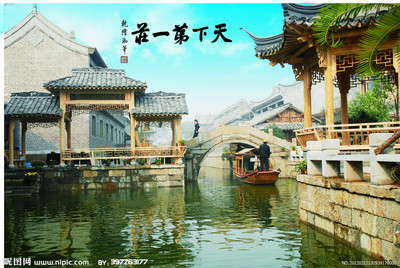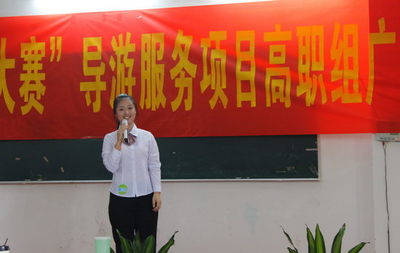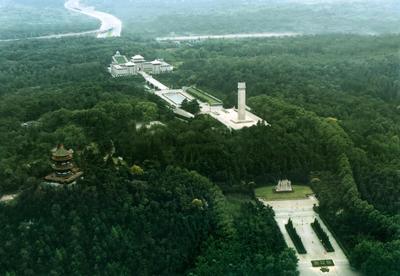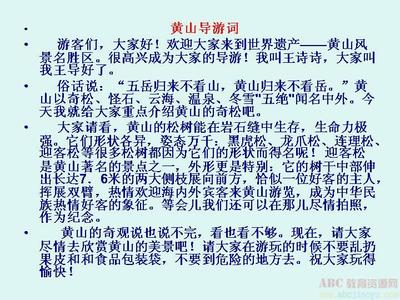
Ladies and gentlemen,
Welcome to Penglai. My name is Miao Meng. I am very pleased tobe at your service as a tour guide today. The first sight we aregoing to visit today is Penglai Pavilion, which is one of the fourmost famous pavilions in China, and it is the symbol of the city.Before our sight-seeing, I’d like to tell you something about thecity.
Situated on the north coast of Shandong Peninsula, Penglai is afamous tourist city in China. It has been know as a fairyland sinceancient time. Why is it called “fairyland”? There may be threereasons. One is from the literature documents. Many ancient booksrecorded that there were three supernatural mountains in the sea tothe east of China. These three supernatural mountains weredescribed as Penglai, Fangzhang and Yingzhou. They were allinhabited by immortals, and there were wonder herbs on themountains. So many noted figures in history came here to seekimmortality and visited places of interest. Emperor Wudi of The HanDynasty came here several times. Of course he couldn’t find thesupernatural mountains. However, he ordered to name this small cityPenglai.
The second reason is related to the well-known legend, “Eightimmortals crossing the sea”. It is said that the eight immortalsgot drunk at Penglai Pavilion and crossed the sea with differenttricks without ship or boats. This legend is so popular in Chinathat it becomes a common saying, “ like the Eight Immortalscrossing the sea, each one showing his or her special feats.” In amoment, we’ll pay a visit to the Eight Immortals.
The third reason has something to do with a natural phenomenon.During spring and summer, mirages sometimes appear above the seanearby Penglai. When this happens, various strange pavilions,terraces, houses and pedestrians seem to appear in the sky abovethe sea surface. They are now visible, now hidden, very mysterious.Many visitors come to view these natural tricks of light reflectionevery year. And wish today we had the luck to view these naturalwonders.
Well, ladies and gentlemen, perhaps you can’t wait. Let’squickly enter the fairyland and have a close look.
Speaking of Penglai Pavilion, in fact, it includes a vast groupof ancient buildings on a land area of 18,900 square meters,composed of six buildings and their attached constructions,including Penglai Pavilion, Tianhou palace, Longwang palace, Luzupalace and Mituo Temple.
Now, in front of us is the magnificent archway which has thename of ‘丹崖仙境’, they mean red hill and fairyland.These four Chinese characters were written by the vice-chairmanDong Biwu when he came here in 1964. Passing the gate, we’re reallyin fairyland now. How do you feel everybody? Would you like to haveyour pictures taken here?
After that archway, we now see three gates from west to east.Now please enter the first gate which is to Longwang Palace. Now wecan see in the middle sits Longwang or the Dragon King, with hiseight followers standing by on both sides. It was said that theDragon King was in charge of rain and has the power to control thesea. So every year many people came here to send tribute to him topray for safety and harvesting fishery on the sea. And when therewas a drought, the county magistrate, taking his people along withhim, came here to worship the Dragon King and ask him to bemerciful to make some rain. At first, many people came to worshipthe Dragon King, but eventually, another new sea goddness took theplace of him. That was the Goddness enshrined in Tianhou Palace.Shall we go and visit her?
Now ladies and gentlemen, we’re in the front courtyard ofTianhou Palace. Here is an opera house where performances are madeevery year during the Temple Fair. It is said that January 16th onChinese lunar calendar is the birthday of Tianhou. People inPenglai have long enjoyed the custom of gathering for the templefair on this day. Coming from all directions to Tianhou Palace,they burn joss sticks to worship the sea godness, to pray and drawdivination sticks, or to donate money for peace and happiness.Farmers from nearby countryside organize operas and yange, apopular rural folk dance here for performance on the stage of theopera house or on the square in front of the pavilion. This is theoccasion when huge crowd of people gathers for fun andentertainment.
Ok, everybody. After seeing the opera house, let’s enter themain palace. It was first built in 1122 in the Song Dynasty, andrebuilt in 1837 after being burnt. It is said that Tianhou is agoddness who was in charge of the sea. People that live in theseaside areas, including the people of Taiwan, are all piousfollowers of her. Here in Penglai she is called Sea Goddness, butin her hometown, Fujian province, she’s affectionately called“Mazu”. The real name of Tianhou was Linmo, and she was born atMaizhou, Fujian province in 960 in the Northern Song Dynasty, and died at the age of 28. It was said that she was unusual when shewas young, and she became godness after death. She always helpedpeople who were in danger on the sea, so she was praised by peopleand was conferred the title of Tianhou by Emperors Kongxi andQianlong in the Qing Dynasty.
Now in front of us is a two-story wooden pavilion. Yes, this isthe very famous Penglai Pavilion. It was first built in 1061 andhas been rebuilt many times during the Ming and Qing Dynasties. Itis one of the four famous pavilions in China. That three Chinesecharacters are “蓬莱阁”, they were written by the famous calligrapherTiebao of the Qing Dynasty, and you’ll have a chance to have a lookat his other works inside the pavilion in a moment. Let’s go in.look at those statue figures, who are they? Can you guess? Yes,they’re the well-known eight immortals. They’re now sitting at asquare table drinking. That square table is called “baxianzhuo” inChinese. Maybe they have been here drinking for decades.
Now let’s go upstairs and enjoy the beautiful scenery here. Whata view! The sea’s wide and blue, dotted with several sailing boatsand some green islands. That hill in the west is called TianhengHill, It is the start of the south end for the division linebetween the Huanghai Sea and the Bohai Sea. On the hill there is anewly built culture park which is beautiful and well-known. Andlook here, this is the famous Penglai Water City which we’re gonnapay a visit this afternoon.
Out of the pavilion, let’s move this way. Now here is the LuzuTemple, and next to it is Sanqing Temple. They’re all DaoismTemples.
Well everybody, we have been on sight-seeing for more than twohours, and we have visited the famous Penglai Pavilion, LongwangTemple, Tianhou Palace, Luzu Temple and Sanqing Temple. It is timefor lunch now, and we’ll go on after the lunch break. Thank you foryour cooperation
 爱华网
爱华网


